Do magnetic bracelets really work for pain relief? Magnetic bracelets have gained widespread popularity in recent years. Many people wear them not only for their sleek appearance but also for their potential health benefits. These stylish accessories contain small magnets embedded in the band. They are designed to rest near the wrist, where pulse points may enhance their effects.
Wearers often report improved energy, reduced discomfort, and better circulation. While scientific evidence remains mixed, countless users claim positive experiences. As a result, magnetic bracelets continue to attract attention from wellness enthusiasts and fashion-conscious individuals alike.
They come in a wide range of materials. Common options include stainless steel, titanium, copper, and leather. Each offers a different look and feel. Some feature strong neodymium magnets, while others use ceramic or flexible magnetic strips.
Moreover, these bracelets suit various lifestyles. Athletes use them during training. Office workers wear them to combat fatigue. Seniors appreciate their lightweight comfort.
In addition to function, design matters. Modern magnetic bracelets blend elegance with purpose. They can be worn daily or paired with formal attire.
Therefore, whether you’re drawn to their aesthetic appeal or curious about their wellness claims, magnetic bracelets offer a versatile option worth exploring.
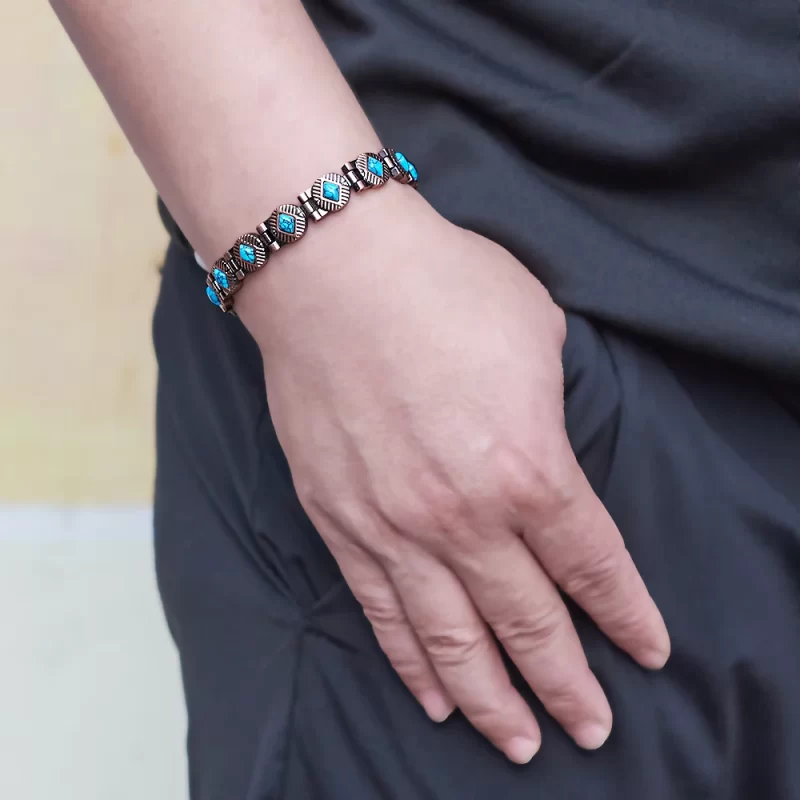 How Magnetic Bracelets Work
How Magnetic Bracelets Work
Magnetic bracelets are designed using principles of magnetism. They aim to provide health benefits by interacting with the human body.
The concept of magnetism
Magnetism is the force generated by magnetic fields. Magnets have north and south poles, which attract or repel other objects with magnetic properties. Magnetic bracelets use static magnets to create consistent magnetic fields. These fields interact with the body when worn.
Magnets are believed to influence electrical charges in the body. They may affect ions and promote certain physiological processes. Although widely used, scientific validation of their impact remains limited.
Interaction with the human body
Magnetic bracelets interact with the body by creating magnetic fields. These fields might stimulate circulation or reduce discomfort. Some believe magnets can balance energy and promote natural healing.
Magnets may influence hemoglobin due to its iron content. This process could potentially improve blood flow. Additionally, magnets might support cellular functions by aligning electrical charges.
While many users report experiencing benefits, results vary from person to person. The interaction largely depends on individual responses to magnetic therapy. Always consult a medical professional for personalized advice.
Potential Health Benefits
Magnetic bracelets have been widely recognized for their potential health benefits. While individual experiences may vary, many users report positive effects. Below, we’ll explore some of the most common benefits associated with wearing magnetic bracelets.
Pain relief and management
Magnetic bracelets are often used to help manage pain. They may relieve discomfort caused by arthritis, headaches, or other chronic conditions. Magnets might reduce pain by influencing blood flow or nerve sensitivity. In some cases, the magnetic fields can help ease muscle or joint pain. While not a guaranteed solution, many find them useful as a complementary therapy.
Improved circulation
Magnets may positively impact blood flow in the body. Some believe they stimulate the iron in hemoglobin, enhancing circulation. Improved blood flow can aid oxygen delivery and nutrient transport to cells. This can support general health, reduce fatigue, and promote healing. Better circulation is also linked to improved skin health and reduced swelling.
Reduced inflammation
Inflammation is the body’s natural reaction to injury. However, excessive inflammation can cause discomfort and harm. Magnetic bracelets might reduce inflammation by enhancing blood flow or aligning electrical charges in cells. This may lower swelling, especially in joints and soft tissues. Reduced inflammation can also relieve symptoms of chronic conditions like arthritis.
While magnetic bracelets are not a cure for medical conditions, they offer potential health benefits. Always seek advice from a healthcare professional before trying magnetic therapy.
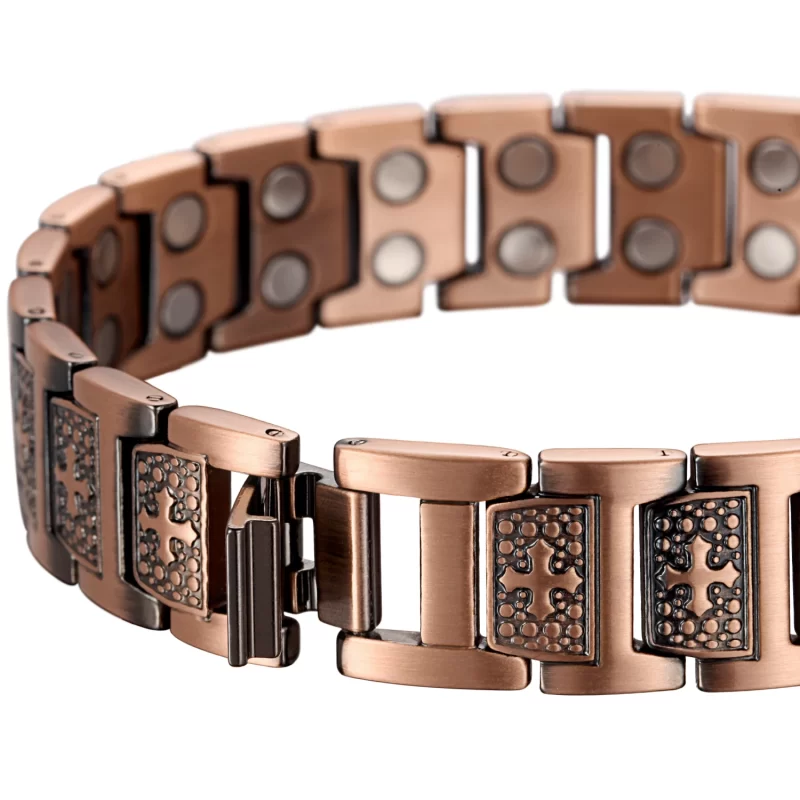 Popular Materials Used in Magnetic Bracelet
Popular Materials Used in Magnetic Bracelet
Magnetic bracelets are available in various materials, offering diverse styles and features. Each material has unique properties that cater to different preferences and needs. Below, we explore the most popular materials used in magnetic bracelets.
Stainless steel
Stainless steel is a durable and affordable material widely used for magnetic bracelets. It is resistant to rust and corrosion, which makes it ideal for long-term use. Stainless steel bracelets are easy to maintain and clean. They also offer a sleek and polished appearance, making them suitable for various occasions. These bracelets are often available in different finishes, including matte and glossy.
Copper
Copper is another popular material for magnetic bracelets. Many people believe it provides health benefits, particularly for joint pain and arthritis. Copper is lightweight and has a warm, natural tone that appeals to many. Over time, copper may develop a unique patina, adding character to the bracelet. However, it may also discolor skin in some users, which can be easily washed off.
Titanium
Titanium is known for its strength and lightweight properties. It is one of the most durable materials used in magnetic bracelets. Titanium is hypoallergenic, making it an excellent choice for those with sensitive skin. Despite its strength, it is incredibly light, offering comfort for daily wear. Titanium bracelets often have a modern and sleek design and are resistant to tarnish.
Choosing the right material for a magnetic bracelet depends on personal preference and lifestyle. All these materials have their unique benefits, so you can find one that suits your needs and style perfectly.
Styles and Designs of Magnetic Bracelet
Magnetic bracelets come in various styles and designs to cater to different tastes and needs. Whether you prefer timeless looks or modern flair, there’s something for everyone.
Classic styles
Classic styles focus on simplicity and elegance. They often feature clean lines and a minimalistic design. These bracelets are perfect for formal occasions or daily wear. Materials like stainless steel and copper are commonly used for classic magnetic bracelets. Their timeless appearance makes them suitable for all age groups.
Contemporary designs
Contemporary designs embrace bold and modern aesthetics. They may include intricate patterns or unique shapes. These bracelets often mix materials like titanium and stainless steel for a trendy look. Some feature embedded gemstones, colorful inlays, or artistic textures. They are ideal for those looking to stand out and make a statement.
Adjustable options
Adjustable magnetic bracelets offer flexibility and comfort. They are designed to fit various wrist sizes effortlessly. Many adjustable styles come with clasps, links, or sliders for easy customization. These bracelets are perfect for individuals who prefer a snug fit or have fluctuating wrist sizes. Adjustability also ensures longevity and ease of use.
Choosing the right style depends on personal preference and lifestyle. Whether you love simple elegance or bold fashion, magnetic bracelets offer diverse designs to match your needs.
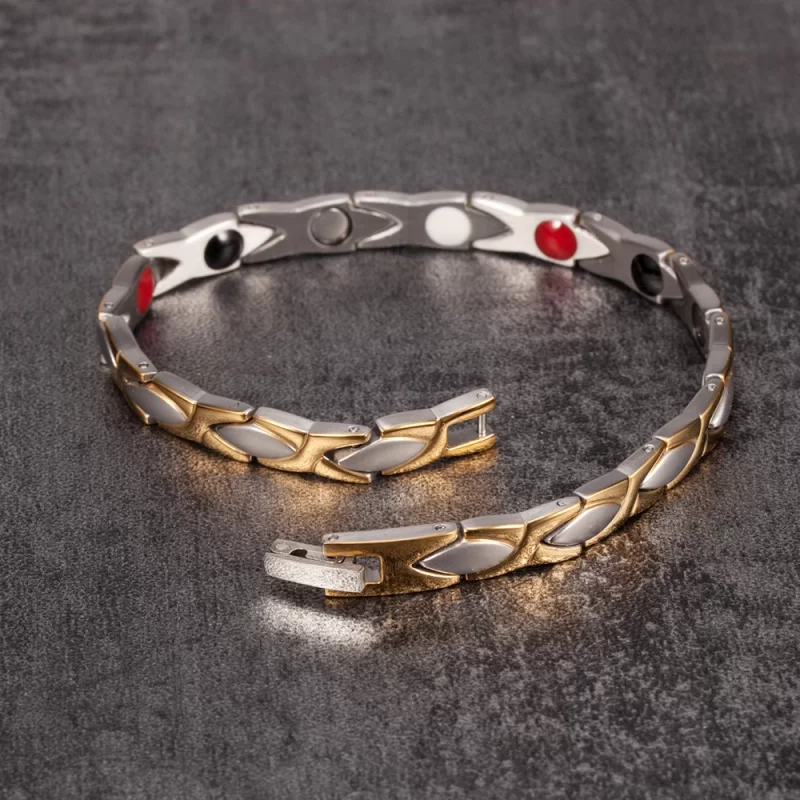 Scientific Studies and Evidence
Scientific Studies and Evidence
Scientific studies on magnetic bracelets aim to understand their health benefits and effectiveness. Researchers have explored how magnets interact with the body, focusing on pain relief, circulation, and inflammation. While some findings suggest potential benefits, results remain inconclusive due to challenges in proving consistent effects.
Current research on magnets and health benefits
The idea of using magnets for health benefits dates back centuries. Modern research attempts to provide scientific backing for their use. A few studies suggest that magnetic fields may help reduce pain or improve blood flow. For instance, some research has observed that static magnets can provide temporary relief in certain pain conditions, such as osteoarthritis or joint discomfort. Others have shown improved blood circulation in specific cases, which may promote healing and reduce swelling.
However, many studies emphasize a placebo effect in observed benefits. In other words, the positive results may arise more from individual belief than from the magnets themselves. Despite this, many users report significant improvements in pain and well-being while using magnetic bracelets.
Limitations and controversies
There are limitations and controversies in the scientific exploration of magnetic bracelets. One challenge is the lack of standardized methods in testing their effectiveness. Study designs vary, making it difficult to compare results between different research projects.
Another limitation is the absence of large-scale, long-term studies. Many existing studies involve small sample sizes or short durations, reducing the reliability of results. Furthermore, some scientists argue that the magnetic fields in these bracelets are too weak to create significant effects on the human body.
Despite anecdotal evidence from users, medical professionals often remain skeptical. The scientific community continues to debate whether magnetic bracelets provide measurable health benefits. Until more rigorous research is conducted, the use of magnetic bracelets should be viewed as a complementary therapy rather than a primary treatment.
Before using magnetic bracelets, consult a healthcare provider. This ensures your safety and addresses individual needs effectively.
How to Choose the Right Magnetic Bracelet
Choosing the perfect magnetic bracelet requires careful consideration. With many options available, focus on key factors to ensure satisfaction and effectiveness. Here’s a guide to help you make the best choice.
Factors to consider
- Material: Select a material that aligns with your comfort and style. Common options include stainless steel, copper, and titanium. Stainless steel is durable and polished, while copper offers potential health benefits. Titanium is lightweight, strong, and suitable for sensitive skin.
- Design: Match the bracelet’s design with your preferences. Choose between classic, modern, or funky styles. Think about the occasions where you’ll wear the bracelet and pick accordingly.
- Magnet strength: Check the type and strength of the magnets used. Stronger magnets may offer more benefits. Look for bracelets with neodymium or hematite magnets, which are common in magnetic therapy products.
- Purpose: Identify your primary reason for wearing the bracelet. Be it style, pain relief, or improved circulation, choose one that meets your needs.
- Build quality: Ensure the bracelet is well-crafted and durable. Good quality guarantees long-lasting use.
- Budget: Balance between cost and quality. Set a budget that reflects your priorities.
- Hypoallergenic properties: If you have sensitive skin, choose materials like titanium or hypoallergenic variants.
Sizing and comfort
- Measure correctly: Measure your wrist circumference accurately before buying. Use a flexible measuring tape for best results.
- Adjustability: Opt for adjustable designs if you prefer flexibility. Many bracelets allow link removal or include adjustable straps.
- Weight: Consider the bracelet’s weight. Lightweight materials like titanium are more comfortable for daily wear.
- Fit: Choose a bracelet neither too tight nor too loose. A snug fit ensures proper magnet contact.
- Clasp type: Different clasp designs, such as magnetic or fold-over, affect ease of use. Choose one that suits you.
When selecting a magnetic bracelet, prioritize your comfort and preferences. A well-chosen bracelet enhances your experience and offers aesthetic and potential health benefits.
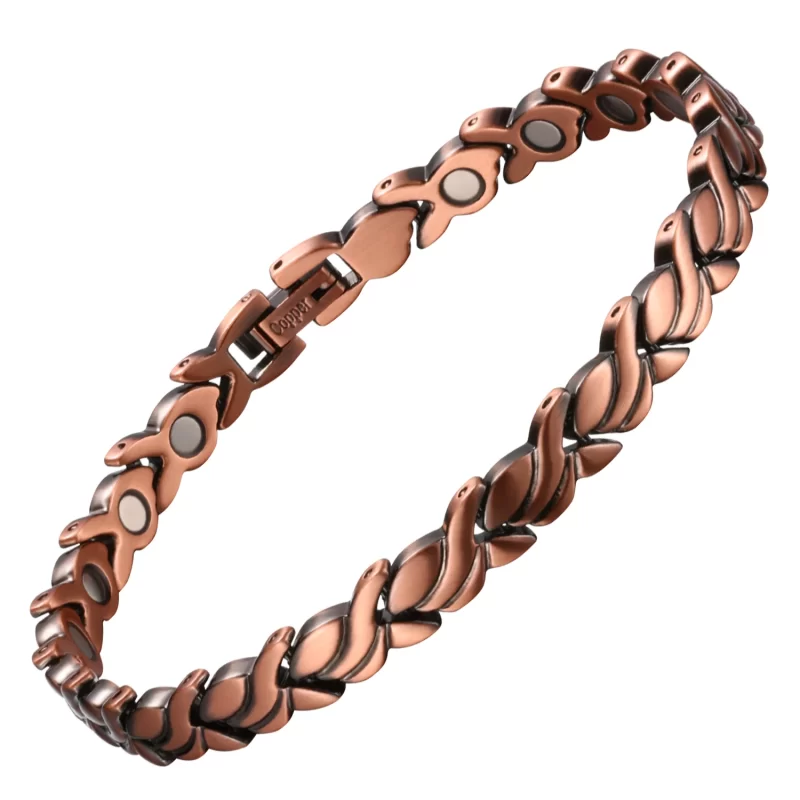 Safety and Precautions
Safety and Precautions
Using magnetic bracelets can provide benefits, but certain precautions are necessary for safe usage.
Potential side effects
While magnetic bracelets are generally safe, some individuals may experience minor side effects. These may include skin irritation or allergic reactions, especially if you are sensitive to certain metals, like nickel or copper. To minimize irritation, ensure the material of the bracelet suits your skin type or opt for hypoallergenic options.
Pregnant individuals and those with implanted medical devices, such as pacemakers or insulin pumps, should avoid wearing magnetic bracelets. Magnets might interfere with these devices and pose risks. Consult a healthcare provider for advice if you have medical conditions or use such devices.
Prolonged use of magnetic bracelets may cause discomfort for some. If you experience any pain or adverse effects, remove the bracelet immediately. It’s vital to listen to your body and assess how you react to the magnetic field.
Best practices for wearing magnetic bracelets
Follow practices to ensure safety and maximize benefits when wearing magnetic bracelets:
- Choose appropriate materials: Select hypoallergenic or skin-friendly materials like titanium or stainless steel.
- Proper fit: Ensure the bracelet fits snugly without being overly tight or loose.
- Limit wear duration: Start with short periods of wear and gradually extend the time. Avoid wearing them continuously for weeks.
- Avoid damaged bracelets: Replace bracelets with damaged magnets to maintain efficacy and safety.
- Prevent magnetic interference: Keep the bracelet away from electronic devices, such as smartphones, credit cards, or medical implants.
- Consult professionals: Speak with your doctor before use, especially if you have health conditions or concerns.
Magnetic bracelets are not cure-all solutions but can complement health-focused routines. Use them wisely for safe benefits.
Frequently Asked Questions About Magnetic Bracelet
Do magnetic bracelets really work?
Results vary. Some users report pain relief and better energy. Scientific evidence is limited but growing.
Can I wear them every day?
Yes. Most are designed for continuous wear. Take breaks if skin irritation occurs.
Are they safe for everyone?
Most adults can use them safely. People with pacemakers or insulin pumps should avoid them.
How long do the magnets last?
Modern magnets retain strength for decades. They do not lose power under normal conditions.
Can I wear them in water?
Some are water-resistant. Stainless steel and silicone models handle splashes. Avoid submerging leather or electronic types.
Do they interfere with watches?
Generally no. But strong magnets may affect mechanical timepieces. Keep a small distance when possible.
Can I sleep with a magnetic bracelet?
Yes. Many find it comforting. Ensure it fits loosely to avoid constriction.
Where should I buy authentic magnetic bracelets?
Choose trusted retailers or official brand websites. Check for product details and customer feedback.
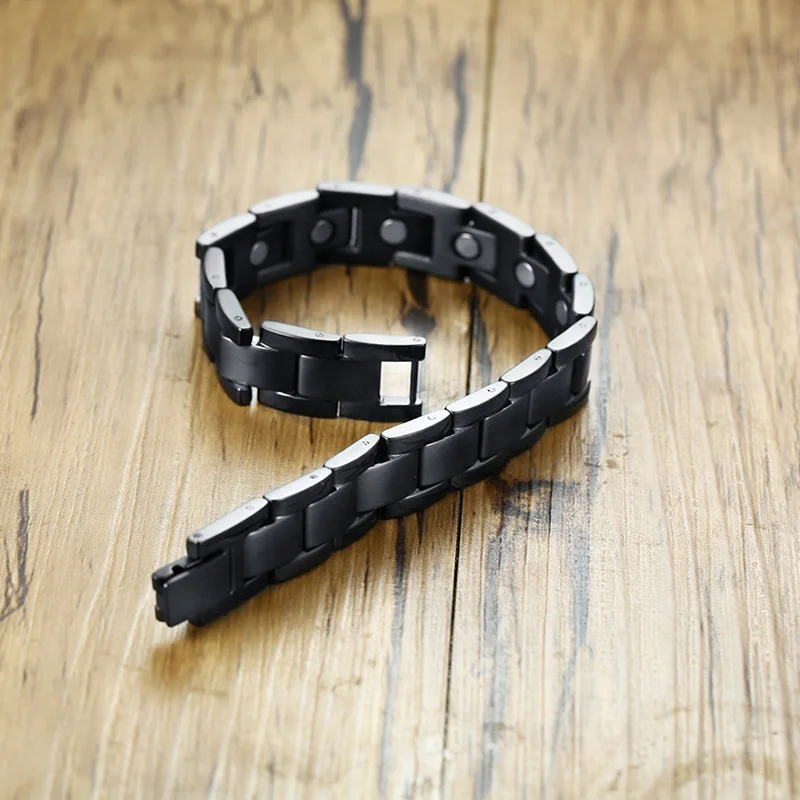 Final Thoughts
Final Thoughts
How to choose the best magnetic bracelet for chronic pain? Magnetic bracelets continue to grow in popularity for good reason. They combine fashion, function, and a sense of well-being in one simple accessory.
From athletes to office professionals, many find value in wearing them daily. While science debates their full impact, user experiences speak volumes.
More importantly, they empower individuals to take small steps toward self-care. Whether used for circulation, comfort, or style, magnetic bracelets offer a non-invasive option.
As awareness spreads, innovation improves. New materials, stronger magnets, and elegant designs keep the market fresh.
Therefore, if you’ve ever considered trying magnetic bracelets, now is a great time. With so many choices available, there’s a perfect pair waiting for you.